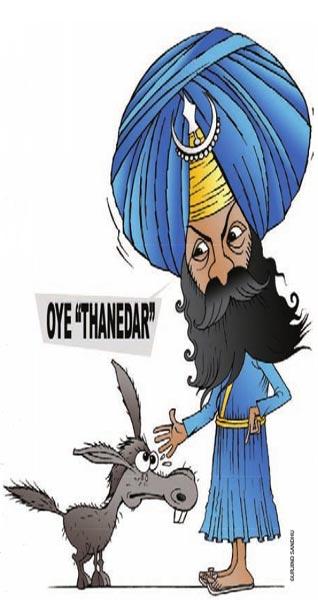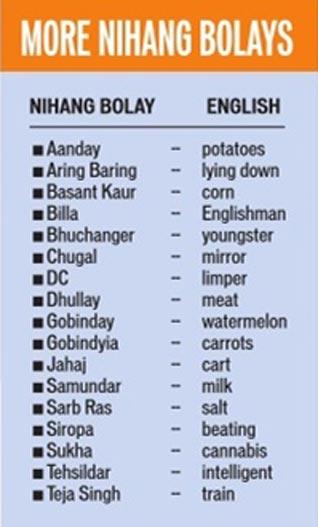Humour
NihangSpeak
by KHUSHWANT SINGH [Chandigarh]
"Give me Nihal Kaur, I want to sleep," I exclaimed to my wife.
Shocked at my audacity to name another woman in the house, she demanded who this "Nihal Kaur" was.
"You are such an illiterate. You don't even know what a
blanket in the Nihang lingo is," I retorted, showing off my latest
acquisition - the 'bolays', or lingo of the Nihang Singhs.
As if
the blunder over Nihal Kaur was not enough, I ordered my house help who
hails from Jharkhand to chop two larraakis and a rupa for salad.
"Larki, rupayya," he asked, sounding even more shocked than my wife.
"Green chillies," I shouted. "And, rupa means onion," I said, trying to teach him my newly acquired Nihang nomenclature.
And from tomorrow
onwards, it is going to be only one cup of dhid phookni (tea) with one
thokhay baj (spoon) of sugar, I told the bewildered Ram Mohan, who by
now thought I'd gone loony.
Having laid my hand on a pamphlet,
which carried the bolays, I was threatening to turn the house into a
Nihang dera. So much so, that when I went to a butcher shop, I asked for
2 kilos of akaash pari (goat).
"We don't keep birds with such names,"
the butcher had replied.
Nihangs, or a band of Sikh warriors of yore, like
many nomadic communities through the centuries, developed a
distinguishable dialect, which came to be known as gargaj bolay (the
thundering language). According to a book by S.J.S, Paul, the Nihang
nomenclature is a mixture of Punjabi, Hindi, Farsi and other dialects
used in various regions of India.
Bolays or words, which form part of the Nihang dialect, usually served military or psychological purposes.
For example, the "larraaki" - red chilli - that I ordered refers to someone with a
fighting nature as a result of the sting it leaves on one's tongue.
"Wear the blue robe and go buy yourself a 300 metre long turban if you want to behave Nihang-like," said my wife.
"I
just might," I replied, since Holla Mohalla is approaching.
"Only if your
akkar-bhan (fever) gets ok," she replied cheekily. My affair with the Nihangs, which is a
combination of awe, love and hatred, dates back to
childhood.
The famous Gurdwara Hariaa(n) Belaa(n) near Hoshiarpur is close
to my village and one of the founders of the gurdwara, Giani Partap
Singh, apparently stayed at our farm while the structure was being
constructed. According to the grapevine, he used to drink his sukha
(a cannabis drink) daily, and one day my grandfather asked him why he locked up his
brain with this crazy substance every day.
"If you can lock as
cheap a thing as hay with a huge padlock, isn't it important to lock a
precious thing like a brain," he is supposed to have replied.
The
association with the dera grew to an extent that to date, while on
their nomadic sojourns, the Nihangs don't mind taking an overnight halt
at our village, at least twice annually, even though their dera (place
of residence) is just a few kilometres away.
Since childhood, I
have seen them send a long list of groceries for themselves and their
araakis (horses) during these halts. In earlier days, they also wouldn't
mind leaving their horses loose in the fields for grazing, leading to
tension. As I grew up, I took up horse-riding as a sport and one day
challenged them to a game of tent pegging.
They would have done well, except that yours truly was in great form on that given day.
"Nihang material!" declared one of the babas after the debacle.
The bolays, according to the website NihangSingh.org, besides reflecting the struggles of the Khalsa, also ridicule those who have opposed the Sikhs at any stage in history. The term for a donkey is "thanedaar", meaning police officer, as Nihangs are renowned for their carefree disregard for worldly authorities, which the police represent.
Muslim priests (Qazis)
encouraged many atrocities on the Sikhs during the Mughal rule in India.
In return, the Singhs use the term Qazi when referring to a cockerel.
Nihang
Singhs refer to their kachherey (briefs) as a chhauni, meaning
encampment. Their kachhera is notoriously large in size and, when hung out to dry, from a far
distance would appear to enemy scouts as tents of the Khalsa warriors;
suggesting the Khalsa warriors numbered far greater than they did. Sava
lakh - a hundred thousand! - to be precise.
The cold refuses to go and Nihal Kaur is not keeping me warm enough. I am back to my aflatoon (quilt) for the time being.
[Courtesy: Punjabi by Nature]
March 14, 2011
Conversation about this article
1: Karanjit Kaur (Melbourne, Australia), March 14, 2011, 10:49 AM.
When a nihang uses the word "thanedaar" (for example), he says "Oye thaanedaara!". There is a distinct tone of utter disdain, not for the donkey, but for the village policeman, who is, more often than not, an oppressor. Sadly, much of the beauty of the dialect is lost in print. And so are the many levels of meaning, because NihangSpeak - unlike other languages - works at several levels. But thank you for this article ... it's brought back fond memories from my childhood, particularly of our frequent run-ins with the nihangs of the neighbourhood.
2: Sangat Singh (Kuala Lumpur, Malaysia), March 14, 2011, 8:25 PM.
May I embellish Khuswant Singh's otherwise excellent piece and add some visuals to it through the eyes of Nick Fleming - a photographer, videographer par excellence who was even inducted as an honorary Nihang. Here is Guru Gobind Singh's checklist of the Khalsa he produced. See how we score today: 1) The Guru's Soldiers. 2) Defender of the Faith. 3) Ferocious in Battle 4) Brave in Adversity. 5) Company of Saints. 6) Unbroken Heritage. 7) Guru Gobind Singh's trusted Keepers of the Khalsa. 9) Fearless. 10) Egoless. 11) Steadfast and True. 12) Brotherhood. 13) Spiritual Warriors. 14) Heart of a Saint. 15) Nomadic. 16) True Sikhs of the Guru. 17) Incorruptible. 18) Expert Horsemen. 19) Courageous. 20) Living Divinely. 21) Meditation. 22) Timeless. 23) Devotion. For visuals I commend the following site: http://www.youtube.com/user/NickFlemingPhoto#p/a/u/2/oceSZk9SWZI
3: I. Singh (Chelmsford, MA, U.S.A.), March 15, 2011, 11:56 AM.
I have my own list that I compiled for a Sikh youth camp class. My favorite one is "bhootni" - literally, female ghost - but in context, it is the steam engine/train which was introduced in India by the British. It brings out the Nihang's disdain for anything non-sovereign. Details of my favorite words available here - http://spiritbornpeople.blogspot.com/2006/09/khls-bol.html
4: Mohan Singh (Toronto, Ontario, Canada), March 18, 2011, 11:52 AM.
"Chaar mile chosathh khide, bees mile kar jod, GurSikh ko GurSikh mile, khide saat karod." This happens when you greet someone with Waheguruji ka Khalsa, Waheguruji ki fateh.




